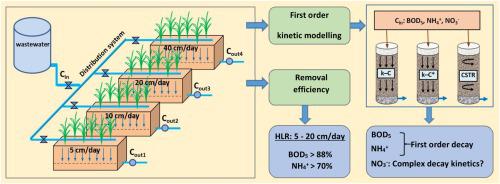Journal of Water Process Engineering ( IF 6.3 ) Pub Date : 2020-07-28 , DOI: 10.1016/j.jwpe.2020.101539 G.M.P.R. Weerakoon , K.B.S.N. Jinadasa , Jagath Manatunge , Buddhi Wijesiri , Ashantha Goonetilleke

|
The design of vertical subsurface flow (VSSF) constructed wetlands (CWs) uses kinetic models to calculate the area based on the kinetic reaction rate constant (k) specific to local environmental conditions and target pollutants. Currently, kinetic modelling does not fully account for the impact of the hydraulic loading rate (HLR), which influences the wetland performance. This study used four experimental VSSF CWs operated at HLRs of 5, 10, 20 and 40 cm/day to investigate the applicability of three first order kinetic models combining plug-flow and continuous stirred tank reactor (CSTR) flow patterns. The target pollutants were BOD5, NH4+ and NO3-. For each pollutant, estimated k values varied between different HLRs and between plug flow and CSTR models. Assessment of uncertainty in kinetic modelling showed that all three models exhibit a similar trend in predicting the concentrations of BOD5 and NH4+ at 5–20 cm/day HLRs. A substantial removal of BOD5 (>88 %) and NH4+ (>70 %) were found for the investigated HLRs, although NO3- removal was not satisfactory. The HLR had a positive impact on mass removal rates (MRRs) for BOD5 and NH4+. Accordingly, 20 cm/day was deemed as the highest viable HLR for designing effective VSSF wetlands for the removal of BOD5 and NH4+. All three models can be employed to design VSSF wetlands at 20 cm/day HLR to treat BOD5 using k values of 0.352 (k-C), 0.380 (k-C*) and 0.996 (CSTR) m/day and to treat NH4+ using k values of 0.170 (k-C), 0.173 (k-C*) and 0.273 (CSTR) m/day.
中文翻译:

热带地区垂直地下流动人工湿地的动力学模型和性能评估
垂直地下流(VSSF)人工湿地(CWs)的设计使用动力学模型,根据特定于当地环境条件和目标污染物的动力学反应速率常数(k)计算面积。当前,动力学建模尚未完全考虑液压负荷率(HLR)的影响,而液压负荷率会影响湿地性能。这项研究使用了四个实验VSSF CW,它们以5、10、20和40 cm / day的HLR运行,以研究结合塞流和连续搅拌釜反应器(CSTR)流型的三个一阶动力学模型的适用性。目标污染物为BOD 5,NH 4 +和NO 3 -。对于每种污染物,估计的k值在不同的HLR之间以及在塞流和CSTR模型之间有所不同。动力学模型不确定性的评估显示,在预测5-20 cm / day HLRs时,所有三种模型在预测BOD 5和NH 4 +的浓度方面都表现出相似的趋势。对于所研究的HLR,发现基本去除了BOD 5(> 88%)和NH 4 +(> 70%),尽管NO 3-去除效果不令人满意。HLR对BOD 5和NH 4 +的质量去除率(MRR)具有积极影响。因此,在设计有效的VSSF湿地以去除BOD时,每天20厘米/天被认为是最高可行的HLR5和NH 4 +。所有这三个模型可以在20厘米/天HLR治疗BOD被用来设计VSSF湿5使用的0.352的k值(KC),0.380(kC的*)和0.996(CSTR)米/天治疗NH 4 +用k值0.170(kC),0.173(kC *)和0.273(CSTR)m /天。











































 京公网安备 11010802027423号
京公网安备 11010802027423号